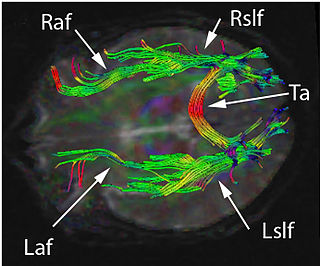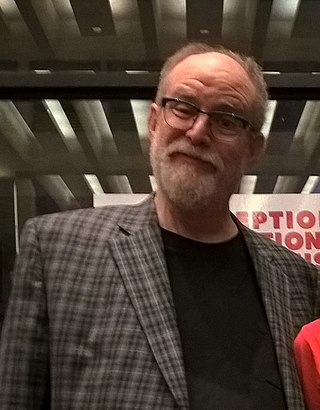Related Research Articles

In aphasia, a person may be unable to comprehend or unable to formulate language because of damage to specific brain regions. The major causes are stroke and head trauma; prevalence is hard to determine, but aphasia due to stroke is estimated to be 0.1–0.4% in the Global North. Aphasia can also be the result of brain tumors, epilepsy, autoimmune neurological diseases, brain infections, or neurodegenerative diseases.

An arteriovenous malformation (AVM) is an abnormal connection between arteries and veins, bypassing the capillary system. Usually congenital, this vascular anomaly is widely known because of its occurrence in the central nervous system, but can appear anywhere in the body. The symptoms of AVMs can range from none at all to intense pain or bleeding, and they can lead to other serious medical problems.

Expressive aphasia is a type of aphasia characterized by partial loss of the ability to produce language, although comprehension generally remains intact. A person with expressive aphasia will exhibit effortful speech. Speech generally includes important content words but leaves out function words that have more grammatical significance than physical meaning, such as prepositions and articles. This is known as "telegraphic speech". The person's intended message may still be understood, but their sentence will not be grammatically correct. In very severe forms of expressive aphasia, a person may only speak using single word utterances. Typically, comprehension is mildly to moderately impaired in expressive aphasia due to difficulty understanding complex grammar.

Wernicke's aphasia, also known as receptive aphasia, sensory aphasia, fluent aphasia, or posterior aphasia, is a type of aphasia in which individuals have difficulty understanding written and spoken language. Patients with Wernicke's aphasia demonstrate fluent speech, which is characterized by typical speech rate, intact syntactic abilities and effortless speech output. Writing often reflects speech in that it tends to lack content or meaning. In most cases, motor deficits do not occur in individuals with Wernicke's aphasia. Therefore, they may produce a large amount of speech without much meaning. Individuals with Wernicke's aphasia often suffer of anosognosia – they are unaware of their errors in speech and do not realize their speech may lack meaning. They typically remain unaware of even their most profound language deficits.
A communication disorder is any disorder that affects an individual's ability to comprehend, detect, or apply language and speech to engage in dialogue effectively with others. This also encompasses deficiencies in verbal and non-verbal communication styles. The delays and disorders can range from simple sound substitution to the inability to understand or use one's native language. This article covers subjects such as diagnosis, the DSM-IV, the DSM-V, and examples like sensory impairments, aphasia, learning disabilities, and speech disorders.

Nut, also known by various other transcriptions, is the goddess of the sky, stars, cosmos, mothers, astronomy, and the universe in the ancient Egyptian religion. She was seen as a star-covered nude woman arching over the Earth, or as a cow. She was depicted wearing the water-pot sign (nw) that identifies her.

Brain injury (BI) is the destruction or degeneration of brain cells. Brain injuries occur due to a wide range of internal and external factors. In general, brain damage refers to significant, undiscriminating trauma-induced damage.

Anomic aphasia is a mild, fluent type of aphasia where individuals have word retrieval failures and cannot express the words they want to say. By contrast, anomia is a deficit of expressive language, and a symptom of all forms of aphasia, but patients whose primary deficit is word retrieval are diagnosed with anomic aphasia. Individuals with aphasia who display anomia can often describe an object in detail and maybe even use hand gestures to demonstrate how the object is used, but cannot find the appropriate word to name the object. Patients with anomic aphasia have relatively preserved speech fluency, repetition, comprehension, and grammatical speech.

William Alan Finn is an American composer and lyricist. He is best known for his musicals, which include Falsettos, for which he won the 1992 Tony Awards for Best Original Score and Best Book of a Musical, A New Brain (1998), and The 25th Annual Putnam County Spelling Bee (2005).

Wernicke's area, also called Wernicke's speech area, is one of the two parts of the cerebral cortex that are linked to speech, the other being Broca's area. It is involved in the comprehension of written and spoken language, in contrast to Broca's area, which is primarily involved in the production of language. It is traditionally thought to reside in Brodmann area 22, which is located in the superior temporal gyrus in the dominant cerebral hemisphere, which is the left hemisphere in about 95% of right-handed individuals and 70% of left-handed individuals.

In neurology, conduction aphasia, also called associative aphasia, is an uncommon form of difficulty in speaking (aphasia). It is caused by damage to the parietal lobe of the brain. An acquired language disorder, it is characterised by intact auditory comprehension, coherent speech production, but poor speech repetition. Affected people are fully capable of understanding what they are hearing, but fail to encode phonological information for production. This deficit is load-sensitive as the person shows significant difficulty repeating phrases, particularly as the phrases increase in length and complexity and as they stumble over words they are attempting to pronounce. People have frequent errors during spontaneous speech, such as substituting or transposing sounds. They are also aware of their errors and will show significant difficulty correcting them.

Joseph Chaikin was an American theatre director, actor, playwright, and pedagogue.
Transcortical sensory aphasia (TSA) is a kind of aphasia that involves damage to specific areas of the temporal lobe of the brain, resulting in symptoms such as poor auditory comprehension, relatively intact repetition, and fluent speech with semantic paraphasias present. TSA is a fluent aphasia similar to Wernicke's aphasia, with the exception of a strong ability to repeat words and phrases. The person may repeat questions rather than answer them ("echolalia").
Landau–Kleffner syndrome (LKS)—also called infantile acquired aphasia, acquired epileptic aphasia or aphasia with convulsive disorder—is a rare childhood neurological syndrome.
Dysprosody, which may manifest as pseudo-foreign accent syndrome, refers to a disorder in which one or more of the prosodic functions are either compromised or eliminated.
Synesthesia is a neurologically based phenomenon in which stimulation of one sensory or cognitive pathway leads to automatic, involuntary experiences in a second sensory or cognitive pathway. There are many occurrences of synesthesia in books, television and film.
Jargon aphasia is a type of fluent aphasia in which an individual's speech is incomprehensible, but appears to make sense to the individual. Persons experiencing this condition will either replace a desired word with another that sounds or looks like the original one, or has some other connection to it, or they will replace it with random sounds. Accordingly, persons with jargon aphasia often use neologisms, and may perseverate if they try to replace the words they can not find with sounds.
Spontaneous recovery is a phenomenon of learning and memory that was first named and described by Ivan Pavlov in his studies of classical (Pavlovian) conditioning. In that context, it refers to the re-emergence of a previously extinguished conditioned response after a delay. Such a recovery of "lost" behaviors can be observed within a variety of domains, and the recovery of lost human memories is often of particular interest. For a mathematical model for spontaneous recovery see Further Reading.
Susan Yankowitz is an American dramatist and novelist who has created works on mortality, violence against women, and the Jonestown Massacre.

My Beautiful Broken Brain is a 2014 documentary film about the life of 34-year-old Lotje Sodderland after she suffered a hemorrhagic stroke as a result of a congenital vascular malformation in November 2011, initially experiencing aphasia, the complete loss of her ability to read, write, or speak coherently.
References
- 1 2 "Night Sky". Samuel French. Archived from the original on January 28, 2012. Retrieved August 27, 2024.
- ↑ Dziemianowicz, Joe; Portantiere, Michael (June 4, 2009). "Susan Yankowitz's 'Night Sky' explores the cosmos and the human brain". NY Daily News. Archived from the original on June 10, 2009. Retrieved July 14, 2012.
- 1 2 Herstein, Beth (June 20, 2009). "Talkin' Broadway – What's New on the Rialto? – Susan Yankowitz – 6/10/09". Talkinbroadway.com. Retrieved July 14, 2012.